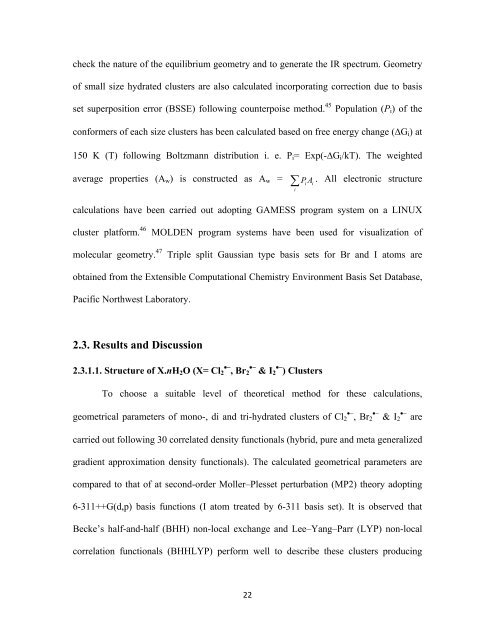CHEM01200604005 A. K. Pathak - Homi Bhabha National Institute
CHEM01200604005 A. K. Pathak - Homi Bhabha National Institute
CHEM01200604005 A. K. Pathak - Homi Bhabha National Institute
You also want an ePaper? Increase the reach of your titles
YUMPU automatically turns print PDFs into web optimized ePapers that Google loves.
check the nature of the equilibrium geometry and to generate the IR spectrum. Geometry<br />
of small size hydrated clusters are also calculated incorporating correction due to basis<br />
set superposition error (BSSE) following counterpoise method. 45 Population (P i ) of the<br />
conformers of each size clusters has been calculated based on free energy change (ΔG i ) at<br />
150 K (T) following Boltzmann distribution i. e. P i = Exp(-ΔG i /kT). The weighted<br />
average properties (A w ) is constructed as A w = PiA<br />
. All electronic structure<br />
i<br />
∑<br />
i<br />
calculations have been carried out adopting GAMESS program system on a LINUX<br />
cluster platform. 46<br />
MOLDEN program systems have been used for visualization of<br />
molecular geometry. 47<br />
Triple split Gaussian type basis sets for Br and I atoms are<br />
obtained from the Extensible Computational Chemistry Environment Basis Set Database,<br />
Pacific Northwest Laboratory.<br />
2.3. Results and Discussion<br />
2.3.1.1. Structure of X.nH 2 O (X= Cl •− 2 , Br •− 2 & I •− 2 ) Clusters<br />
To choose a suitable level of theoretical method for these calculations,<br />
geometrical parameters of mono-, di and tri-hydrated clusters of Cl •− 2 , Br •− 2 & I •− 2 are<br />
carried out following 30 correlated density functionals (hybrid, pure and meta generalized<br />
gradient approximation density functionals). The calculated geometrical parameters are<br />
compared to that of at second-order Moller–Plesset perturbation (MP2) theory adopting<br />
6-311++G(d,p) basis functions (I atom treated by 6-311 basis set). It is observed that<br />
Becke’s half-and-half (BHH) non-local exchange and Lee–Yang–Parr (LYP) non-local<br />
correlation functionals (BHHLYP) perform well to describe these clusters producing<br />
22
















